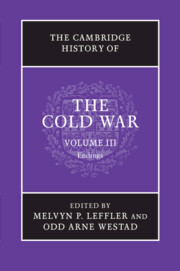Book contents
- Frontmatter
- 1 The Cold War and the intellectual history of the late twentieth century
- 2 The world economy and the Cold War, 1970–1990
- 3 The rise and fall of Eurocommunism
- 4 The Cold War and Jimmy Carter
- 5 Soviet foreign policy from détente to Gorbachev, 1975–1985
- 6 Islamism, the Iranian revolution, and the Soviet invasion of Afghanistan
- 7 The collapse of superpower détente, 1975–1980
- 8 Japan and the Cold War, 1960–1991
- 9 China and the Cold War after Mao
- 10 The Cold War in Central America, 1975–1991
- 11 The Cold War and southern Africa, 1976–1990
- 12 The Gorbachev revolution and the end of the Cold War
- 13 US foreign policy under Reagan and Bush
- 14 Western Europe and the end of the Cold War, 1979–1989
- 15 The East European revolutions of 1989
- 16 The unification of Germany, 1985–1991
- 17 The collapse of the Soviet Union, 1990–1991
- 18 Science, technology, and the Cold War
- 19 Transnational organizations and the Cold War
- 20 The biosphere and the Cold War
- 21 The Cold War and human rights
- 22 The Cold War in the longue durée: global migration, public health, and population control
- 23 Consumer capitalism and the end of the Cold War
- 24 An ‘incredibly swift transition’: reflections on the end of the Cold War
- 25 The restructuring of the international system after the Cold War
- Bibliographical essay
- Index
- References
7 - The collapse of superpower détente, 1975–1980
Published online by Cambridge University Press: 28 September 2010
- Frontmatter
- 1 The Cold War and the intellectual history of the late twentieth century
- 2 The world economy and the Cold War, 1970–1990
- 3 The rise and fall of Eurocommunism
- 4 The Cold War and Jimmy Carter
- 5 Soviet foreign policy from détente to Gorbachev, 1975–1985
- 6 Islamism, the Iranian revolution, and the Soviet invasion of Afghanistan
- 7 The collapse of superpower détente, 1975–1980
- 8 Japan and the Cold War, 1960–1991
- 9 China and the Cold War after Mao
- 10 The Cold War in Central America, 1975–1991
- 11 The Cold War and southern Africa, 1976–1990
- 12 The Gorbachev revolution and the end of the Cold War
- 13 US foreign policy under Reagan and Bush
- 14 Western Europe and the end of the Cold War, 1979–1989
- 15 The East European revolutions of 1989
- 16 The unification of Germany, 1985–1991
- 17 The collapse of the Soviet Union, 1990–1991
- 18 Science, technology, and the Cold War
- 19 Transnational organizations and the Cold War
- 20 The biosphere and the Cold War
- 21 The Cold War and human rights
- 22 The Cold War in the longue durée: global migration, public health, and population control
- 23 Consumer capitalism and the end of the Cold War
- 24 An ‘incredibly swift transition’: reflections on the end of the Cold War
- 25 The restructuring of the international system after the Cold War
- Bibliographical essay
- Index
- References
Summary
In October 1974, Henry A. Kissinger, the US secretary of state, met with Soviet leader Leonid Brezhnev in Moscow to discuss unresolved arms-control matters before the upcoming US–Soviet summit in Vladivostok. They made progress but still noted that détente – the finely calibrated reduction of US–Soviet tensions that their two governments had presided over in the previous few years – was in fact “hanging by a thread.” Both men knew only too well what the alternative would be. As the recently resigned US president, Richard M. Nixon, had warned Brezhnev a few months earlier: “if détente unravels in America, the hawks will take over, not the doves.”
Eventually they did. By the end of 1980, US–Soviet relations were freezing, with few economic transactions, daily exchanges of hostile words, and growing concerns among American and Soviet citizens about their countries’ military competition. Since détente was motivated by a desire to stabilize the nuclear arms race, enhance bilateral cooperation, and decrease the ideological and geopolitical rivalry between the superpowers, its fate was increasingly apparent.
The collapse of superpower détente did not happen overnight. Nor was it caused by a single, overwhelming destructive force, like an earthquake or tsunami. Rather, it was a slow, eroding process, in which multiple events and forces added strength to one another and gradually tore apart the delicate fabric of lofty ideas, pragmatic assumptions, and half-sincere obligations associated with détente.
- Type
- Chapter
- Information
- The Cambridge History of the Cold War , pp. 135 - 155Publisher: Cambridge University PressPrint publication year: 2010
References
- 6
- Cited by

